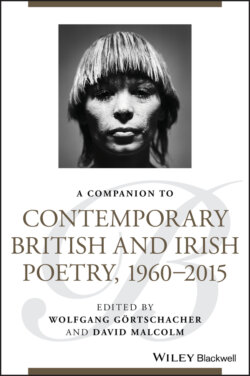Читать книгу A Companion to Contemporary British and Irish Poetry, 1960 - 2015 - Группа авторов - Страница 17
Seamus Heaney, “Requiem for the Croppies” (1966) (Heaney 1990, 12)
ОглавлениеThe title of the poem unambiguously announces a defiance of empire, and goes on to offer precisely what the title announces—a laudatory dirge for Irish rebels. Strikingly, this threnody for insurrection is enacted within a metropolitan and traditional English‐language genre, for the requiem is a sonnet, albeit one that deviates from traditional established models.
Such deviation occurs on several levels. This sonnet is a narrative sonnet, not a lyric expression of feeling. The speaker is plural, not the traditional singular one. Subject matter does not quite fit the traditional octave/sestet division. Lines 1–4 form a focused quatrain, but the next subject (the Croppies' tactics) runs from line 5 to line 9. The remaining five lines are, thus, a decapitated sestet. Lines are mostly 10 syllables long, although six lines are longer, and lines 9, 10, 11, and 14 are considerably longer. The numbers of main stresses per line are also variable (from three to six), and the last line can legitimately be read as having between four and six main stresses. The poem certainly has iambic elements, and anywhere between six and eight feet can be scanned as iambs or diambs. But six, and possibly seven, feet are trochees or ditrochees. There are several rather long feet: for example, “through reins and rider” (line 7) should probably be scanned x/x/x; “cattle into infantry” (line 8)—/xxx/xx; and “in our broken wave” (line 12)—xx/x/. Six lines end in an unstressed syllable.
Rhyme is disruptive. The rhyme scheme template itself—abab cdcd efe efe—is not that of an established sonnet template. Further, 6 out of 14 lines end in a questionable rhyme: “barley / country” (1, 3), “infantry / day” (6, 8), “cannon / thrown / coffin” (9, 11, 13), and “conclave / wave / grave” (10, 12, 14). In this last sequence, “wave / grave” is a full rhyme, but “conclave” rhymes anisobarically with both.
The poem is an elegy for rebellion and a smack in the face to established authority. The sonnet tradition (high status, metropolitan, relatively rigid) is appropriated and undermined, perhaps by a folk tradition with its narrative celebration of outlaws and rebels and its freedom with rhyme. Like Harwood, and not like Larkin, Heaney is unambiguous about empire and history.
